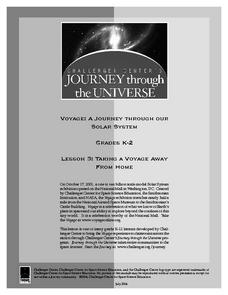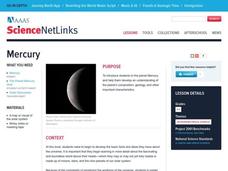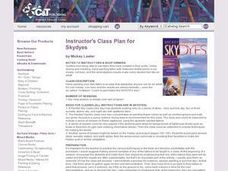American Museum of Natural History
A Closer Look at Mars
A website looks at how we know so much about Mars—telescopes, robots, and spacecraft—and the search for martian life. Following the informational text are three questions that quiz pupils about possible life on Mars.
Curated OER
Two-Point Perspective
Seventh graders will learn to create the illusion of depth on a two dimensional surface using the technique of perspective.Analyze famous works of art and photographs of local architecture and identify how each is using perspective....
Curated OER
Vocab-u-lous! Build a Fabulous Vocab: Words Beginning with SC
In this vocabulary worksheet, students select the best word choice to complete the sentence. They are challenged with words that have sc-blends.
Curated OER
Lunar Learning
Students learn about the phases of the moon. In this moon phases lesson, students learn about what causes the moon to look different to us everyday and how the Earth and Sun's position determine what phase the moon is in.
Curated OER
How the Chipmunk Got its Stripes
In this comprehension worksheet, students complete multiple choice and short answer questions for the legend How the Chipmunk Got Its Stripes. Students complete 8 questions total.
Curated OER
Our Changing View of the Solar System
Students identify and name the eight planets and the five dwarf planets in our solar system. In this space science lesson, students view a slideshow of the planets and label them on an included Solar System chart.
Curated OER
Timekeeping by the Sun
Students measure shadows to learn about the Sun-Earth relationship. In this astronomy lesson, students create a shadow stick of a Pokemon character and record measurements of its shadow in a data chart. Follow-up discussions guide...
Curated OER
Cloudy with a Chance of Meatballs Activities
"Cloudy with a Chance of Meatballs", in its book or movie form, rains down lesson possibilities.
Curated OER
Wacky Weather
In this weather worksheet, students read a 3 page story about a girl who notices unusual weather patterns. Included in the story is information about climate, temperature, tides and wind. Students then answer 6 essay questions.
Curated OER
What Shape is the Moon Tonight?
Young scholars understand that the moon appears differently throughout the month. In this phases of the moon lesson, students observe and record the phases of the moon.
Curated OER
Phase to Phase with the Moon
Fourth graders study the Moon phases. The lesson includes hands-on activities as well as web-based activities. They use models of the Moon and a lamp to study each of the phases of the Moon, and test their knowlege of the Moon on a web...
Curated OER
Taking a Voyage away from Home
Students experience and participate in a journey through a "Voyage" exhibition of the Solar System and the frontier it covers. They build a dynamic model of the Earth and Sun. Descriptions are given on the relative sizes of the Sun and...
Curated OER
The Little Fluffy White Cloud
In this reading comprehension worksheet, students read, analyze and interpret the short story "The Little Fluffy White Cloud" and then answer eighteen comprehension questions about the short story.
Curated OER
Sampling Rocks
Students investigate rocks. In this earth science instructional activity, students collect rocks from the schoolyard and describe each of the rocks. Students measure and weigh each rock and record the results. Students create a rock...
Curated OER
Country Sayings Exercise
In this idioms instructional activity, students read 12 country expressions or colloquial expressions and then match each with its correct meaning, Students then write down 3 colloquial expressions or idioms from their language and...
Curated OER
Lunar Cycle
Students recognize that the eight phases of the moon repeat. For this lunar cycle lesson, students experiment to understand the phases of the moon. Students make observations and complete a "the Moon I See" worksheet. Students...
Curated OER
Phases of the Moon
For this moon phases worksheet, students learn about the different phases that the moon goes through. They then use the information the learned to answer the 9 questions in the packet. The answers are on the last page.
Curated OER
Five Fingers for Eating Lunch
First graders listen to the book, The M&M's Brand Counting Book, discuss the one-to-one correspondence and count the candies in the story. They focus on the number five, and listen to the story Sun Up, Sun Down, discussing the...
Curated OER
Mercury
Students study the planet Mercury and develop an understanding of the planet's composition, geology, and other important characteristics. They explore a Web resource on the planet Mercury which is the central focus of this lesson.
Curated OER
Cosmic Wheels
Learners build a scale model of the Solar System and determine the time other planets take to travel around the Sun in comparison to the time of the Earth's revolution. The velocity of the planets are also determined in this lesson.
Curated OER
Moon
Students discover scientific facts about the Moon and how
some American Indian Tribes used the moon to measure time.
They accomplish this by listening to stories and poetry, writing
stories, communicating with an astronaut,...
Curated OER
SKYDYES
Students use fabric they have created in their quilts. Unlike dyeing and marbling, hand-painting fabric with Setacolor textile paints is not messy, not toxic, and the serendipitous results make every student feel like an artist!
Curated OER
Measuring Elevation
Students practice measuring elevation, one of the key coordinates used by astronomers. They describe how the elevation of an object is measured.
and combine compass directions and elevation to find celestial objects.
Curated OER
Vocabulary Reading Comprehension-Grade Five
In this vocabulary comprehension worksheet, students read a passage about locust, then complete 7 multiple choice questions. An answer key is provided.

























